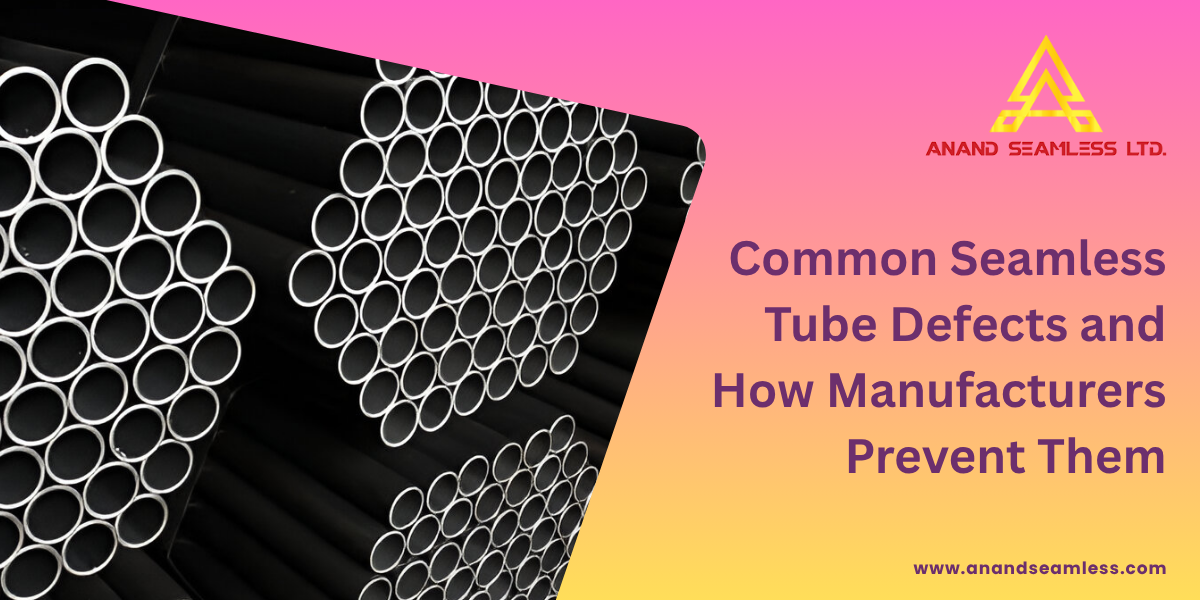Quick Inquiry
Seamless tubes are the backbone of many critical applications—oil and gas pipelines, heat exchangers, boilers, hydraulic systems, and more. Known for their strength, corrosion resistance, and ability to withstand high pressure, seamless tubes play a vital role in safety, performance, and reliability.
But not all tubes are created equal. Defects in these tubes can lead to serious operational failures, downtime, and even hazardous incidents. That’s why it’s crucial to understand the most common seamless tube defects—and more importantly, how a manufacturer prevents them through stringent processes and quality control.
Let’s explore the most prevalent defects found in seamless tubes and how top manufacturers ensure defect-free output from start to finish.

What Are Seamless Tubes?
Seamless tubes are cylindrical steel products with no welded seams, created using solid round billets that are pierced and rolled into a tube. This manufacturing method gives them higher strength and uniformity compared to welded tubes, making them ideal for high-stress environments.
Key Features of Seamless Tubes:
- Superior mechanical strength
- High corrosion resistance
- Excellent dimensional accuracy
- Capable of withstanding high-pressure and temperature conditions
- Preferred for critical and corrosive industrial applications
Now, let’s move into what can go wrong during their production.
Common Seamless Tube Defects
Despite being engineered for precision, seamless tubes can exhibit certain defects if not manufactured under strict process control. Below are the most frequently observed defects:
1. Laminations
What it is: Laminations are internal or external surface separations or discontinuities that run parallel to the tube axis. They often occur due to non-metallic inclusions or voids in the raw billet.
Risks:
- Compromised tube strength
- Increased susceptibility to cracking under pressure
- Poor surface finish
Prevention by quality manufacturers:
- Use of high-quality billets with ultrasonic testing
- Pre-processing billet inspection and conditioning
- Strict control of piercing operations
2. Seam Marks or Scars
What it is: Scars or seam-like marks may appear on the outer surface of the tube during hot rolling or if the piercing tool is worn out.
Risks:
- Cosmetic defects affecting aesthetic or coating applications
- May indicate deeper inconsistencies if not properly inspected
Prevention by quality manufacturers:
- Regular tool maintenance and replacement
- Controlled rolling temperature and pressure
- Visual inspection followed by eddy current testing
3. Centerline Cracks
What it is: Cracks that form along the centerline during hot working or extrusion, typically due to poor billet conditioning or excessive strain during rolling.
Risks:
- Potential for fatigue failure
- Reduced load-bearing capacity
- Not suitable for high-pressure uses
Prevention by quality manufacturers:
- Controlled heating cycles during extrusion
- Proper alignment of rolls and piercing tools
- Inline ultrasonic testing for crack detection
4. Eccentricity
What it is: Eccentricity occurs when the wall thickness of the tube varies beyond acceptable limits, often due to uneven deformation during piercing or rolling.
Risks:
- Uneven pressure distribution
- Reduced durability in hydraulic and pressure systems
Prevention by quality manufacturers:
- Use of automated wall thickness measurement systems
- Calibration of rolling and sizing mills
- Digital feedback systems to auto-correct rolling imbalance
5. Surface Pitting or Scaling
What it is: Oxide scales or surface pits form due to improper temperature control, poor descaling, or environmental exposure post-manufacture.
Risks:
- Surface weakness
- Poor bonding for coatings or lining
- Corrosion initiation points
Prevention by quality manufacturers:
- Use of protective atmosphere furnaces or controlled descaling
- Post-process pickling or polishing
- Surface testing using magnetic flux or dye penetrants
6. Quench Cracks
What it is: Cracks caused during the heat treatment process, particularly during rapid quenching of thick-walled tubes.
Risks:
- Catastrophic failure under thermal cycling
- Internal stress concentration points
Prevention by quality manufacturers:
- Precision control over quench media temperature and agitation
- Gradual cooling techniques for thicker tubes
- Non-destructive testing (NDT) after heat treatment
7. Straightness Deviation or Bowing
What it is: This defect refers to the deviation of the tube from a perfectly straight axis, usually due to uneven cooling or misaligned rolling.
Risks:
- Installation issues
- Reduced fitment accuracy in automated systems
Prevention by quality manufacturers:
- Online straightness monitoring systems
- Cooling bed alignment and roller tension control
- Final-stage mechanical straightening
Request a Sample
How a Quality Seamless Tube Manufacturer Ensures Zero-Defect Products
To deliver tubes that meet strict industrial standards, a trusted seamless tube manufacturer focuses on prevention rather than correction. Here’s how top-tier manufacturers maintain quality across every step:
1. Raw Material Inspection
A quality manufacturer never compromises on the billet. Every billet is tested for chemical composition, inclusions, and internal defects using:
- Ultrasonic Testing (UT)
- Magnetic Particle Inspection (MPI)
- Visual inspection for surface cracks or oxidation
2. Precision Piercing & Rolling
Piercing the billet is the most critical step. High-quality manufacturers:
- Use lubricated, defect-free piercing plugs
- Maintain exact temperature for hot working
- Calibrate piercing mill alignment regularly
3. In-Process Non-Destructive Testing (NDT)
Top manufacturers integrate NDT right into the production line, such as:
- Eddy Current Testing for surface defects
- Ultrasonic Testing for internal flaws
- Radiographic Testing for structural consistency
4. Heat Treatment and Annealing Controls
Seamless tubes are often normalized or annealed to enhance grain structure and mechanical properties. During this:
- Precision-controlled furnaces are used
- Quenching processes are monitored for stress relief
- Metallurgical microstructure is verified using lab tests
5. Cold Drawing and Sizing
For dimensional accuracy and superior finish, tubes undergo cold drawing and sizing. High-quality plants:
- Use computer-controlled sizing dies
- Measure wall thickness with laser micrometers
- Ensure consistent outer diameter and ovality
6. Final Inspection and Documentation
Before dispatch, seamless tubes are:
- Visually inspected under lighting systems
- Tested for dimensions, hardness, pressure, and corrosion
- Provided with full traceability reports and mill test certificates (MTC)
Why It Matters to Choose the Right Seamless Tube Manufacturer
Whether you’re in petrochemicals, energy, automotive, or infrastructure, the reliability of seamless tubes affects your project’s success. Choosing a reputed seamless tube manufacturer ensures:
- Certified quality across global standards (ASTM, ASME, EN)
- On-time delivery with consistent performance
- Long-term cost savings from fewer replacements and failures
- Customized solutions for specific grades and applications
Final Thoughts
Seamless tube defects are not just minor flaws—they can be project dealbreakers. As demand rises for durable, high-performance tubing in critical sectors, the role of quality-focused seamless tube manufacturers becomes more vital than ever.
By understanding what defects to watch for and how top manufacturers prevent them, you can make smarter sourcing decisions that protect your investments, performance, and safety standards.
Partner with the Right Seamless Tube Manufacturer
When it comes to seamless tubes, even the smallest defect can lead to major setbacks in performance, safety, and cost. That’s why sourcing from a trusted seamless tube manufacturer isn’t just a purchase decision—it’s a quality commitment. Whether you’re building for oil & gas, automotive, power plants, or heavy engineering, at Anand Seamless Limited, our defect-free, precision-engineered seamless tubes are designed to deliver unmatched strength, durability, and consistency. Backed by advanced manufacturing, in-line testing, and global certifications, we help you stay ahead of failures and downtime.
Looking for seamless tubes that meet international standards and exceed expectations? Let’s talk. Contact us at +91-9099996853 for a custom quote or schedule a consultation with our technical team.
lATEST BLOG |
|
Finned Tube Heat Exchanger Selection Guide for Rice Mills, Dairy and Food Plants in India
A finned tube heat exchanger is one of the most im |
|
Why Cold-Drawn Tubes Are the Best Choice for Aerospace Component Manufacturing
When it comes to aerospace manufacturing, the sele |
|
How Seamless Steel Pipes Ensure Safety in High‑Pressure Boiler Systems
When it comes to ensuring the safe operation of hi |
|
Why Seamless Tubes and Pipes Are Gaining Popularity in Heavy-Duty Industries
In the world of heavy-duty industries, where high |
|
How Finned Tubes Help Combat Fouling in Heat Exchangers: Solutions for Clean Heat Transfer
Heat exchangers are the heart of many industrial s |

